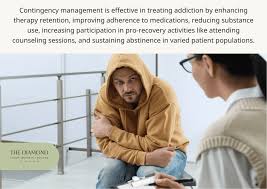Lifestyle
Contingency Management in Addiction Treatment: A Path to Lasting Recovery

Each year, millions of Americans struggle with addiction, finding the road to sustained recovery filled with difficult turns. Staying sober, attending therapy, and building a new life takes immense effort. What if there was a proven way to give people a powerful boost toward these goals? Contingency Management (CM) is a behavioral intervention that uses positive reinforcement, like rewards, to encourage healthy choices and active participation in addiction treatment. This article explores the core principles, significant benefits, and practical ways to use contingency management in addiction treatment, showing its effectiveness as a tool for recovery.
Understanding the Principles of Contingency Management
Contingency management builds on simple, yet powerful, ideas about how people learn. It is all about linking good actions with good outcomes.
Reinforcement and Behavior Change
We often do more of what brings us good things. This is the heart of reinforcement. Positive reinforcement means giving a reward after a desired behavior, making that behavior more likely to happen again. Think of getting a voucher for a negative drug test. Negative reinforcement, though less common in CM, involves removing something unpleasant. For instance, successfully staying sober might remove the need for more frequent drug testing down the line.
CM is deeply rooted in operant conditioning. This is a learning process where behaviors are changed by the things that happen after them. When a person gets a reward for staying sober, their brain learns to connect sobriety with positive feelings and outcomes. This helps them choose sobriety more often. Reinforcers come in many forms. Tangible rewards include gift cards, movie tickets, or vouchers for goods and services. Social reinforcement means praise, recognition, or extra privileges. Sometimes, symbolic rewards like tokens or points are used, which can later be traded for something of value.
Key Components of a CM Program
A good CM program is clear and consistent, making sure everyone knows what to expect.
- Behavioral Goal: Every program starts with a clear target. This could be showing up for therapy sessions, giving clean drug tests, or reaching other treatment milestones. The goal is specific and measurable.
- Reinforcement Schedule: This sets when and how often rewards are given. A fixed-ratio schedule gives a reward after a certain number of correct actions. A variable-ratio schedule, like a lottery, offers rewards after an unpredictable number of correct actions, often keeping motivation high. Fixed-interval gives rewards after a set time if the behavior occurs, while variable-interval offers rewards after changing time periods.
- Monitoring and Verification: You cannot reward what you cannot confirm. CM uses objective ways to check behavior. This includes urine drug screens, breathalyzers, or attendance logs to make sure the target behavior actually happened. This step builds trust and fairness.
- Consequences for Non-Compliance: What happens if the person does not meet the goal? In CM, not meeting the goal simply means no reward is given. It’s not about punishment, but about withholding the positive reinforcement. This gentle approach keeps the focus on rewarding progress.
The Proven Benefits of Contingency Management
CM isn’t just a theory; it is backed by years of research showing real-world results. This approach helps people stick with their treatment and find lasting change.
Enhanced Treatment Engagement and Retention
One big challenge in addiction treatment is keeping people involved. CM helps here.
- Increased Attendance: CM gives people a reason to show up. When therapy attendance or group participation leads to a reward, people are much more likely to be present and active. This consistent attendance helps them get the full benefit of their treatment plan.
- Reduced Dropout Rates: Research consistently shows that CM can significantly lower the number of people who leave treatment early. When there’s a clear, positive incentive, individuals feel more committed. This translates to fewer relapses and better chances of long-term recovery compared to standard care alone.
- Motivation for Change: Rewards can be a powerful spark, especially for those early in recovery. They can help push through tough cravings or a lack of self-motivation. The tangible nature of CM rewards helps individuals stay focused on their sobriety goals, even when internal motivation feels low.
Promotion of Abstinence and Reduced Substance Use
The most direct benefit of CM is how it helps people stop using substances.
- Direct Reinforcement of Sobriety: CM directly rewards verified abstinence. Each clean drug test or sober day earns a reward, creating a powerful positive feedback loop. This direct link makes sobriety more appealing and achievable. It helps people build a streak of sober days.
- Long-Term Behavioral Shifts: Consistent positive reinforcement does more than just stop current substance use. It helps create new, healthier habits. Over time, these reinforced actions become more ingrained, leading to more sustainable changes. This makes relapse less likely in the future.
- Case Study/Example: For instance, programs for stimulant use disorder, like cocaine or methamphetamine addiction, have seen great success with CM. People in these programs often show longer periods of abstinence and fewer drug-positive tests when rewards are part of their treatment plan.
Improved Treatment Outcomes and Functioning
The ripple effects of CM go beyond just stopping drug use, touching many areas of a person’s life.
- Mental Health Improvements: When individuals achieve sobriety through CM, they often experience a reduction in co-occurring mental health issues. Less substance use can mean less anxiety, fewer depressive symptoms, and a more stable mood. It creates a clearer path for mental wellness.
- Social and Vocational Rehabilitation: Getting rewards for staying sober can indirectly boost other life areas. As people stay engaged in treatment and abstain from substances, they often find it easier to improve relationships, secure employment, and boost their overall quality of life. CM sets the stage for a fuller, more productive life.
- Cost-Effectiveness: Studies suggest that CM can be very cost-effective. By reducing relapse rates and increasing treatment success, it can lower healthcare costs. It also cuts down on societal costs related to crime and lost productivity due to addiction. Investing in CM now can save money later.
Implementing Contingency Management Effectively
Making CM work well takes careful planning and thought. It’s not a one-size-fits-all approach.
Designing a CM Program
A strong CM program starts with understanding the people it serves.
- Needs Assessment: Before starting, it is crucial to understand the specific needs of the group. What works for one person may not work for another. Programs should be culturally sensitive and address the unique challenges of the target population. This helps tailor the rewards and goals.
- Selecting Appropriate Reinforcers: The rewards must be something the client desires. What motivates one person might not motivate another. Ethical considerations are also key; rewards should be accessible, safe, and not create new problems. Gift cards, healthy activities, or items for daily living often work well.
- Establishing Clear Rules and Procedures: Everyone involved needs to understand the program’s rules. Transparency is vital. When guidelines are clear and applied consistently, trust builds. This ensures fairness and helps clients know exactly what they need to do to earn rewards.
Practical Considerations and Challenges
Even with clear benefits, running a CM program has its hurdles.
- Resource Allocation: CM programs need funding for rewards and staff to manage them. This means thinking about financial and staffing resources. Finding ways to sustain the reward system is crucial for long-term success. Community partnerships can often help with this.
- Ethical Considerations: Some people worry about “paying” someone to be sober. However, CM is not about bribing; it’s about shaping behavior with positive reinforcement. It’s important to ensure rewards aren’t seen as coercive and that the program respects individual autonomy. The goal is to support health, not manipulate.
- Addressing Relapse: Relapse is often part of recovery. When a lapse occurs, CM programs should not completely shut down. Instead, they should have clear steps to help the person get back on track. This might mean pausing rewards or returning to an earlier stage, but always with a path forward.
- Expert Quote/Reference: As Dr. Nancy Petry, a leading CM researcher, often states, “The power of CM lies in its simplicity and directness in reinforcing desired behavior. But consistency and clear communication are key to its success.”
Adapting CM for Different Populations and Settings
CM is versatile and can be shaped to fit many situations.
- Opioid Use Disorder: For opioid addiction treatment, CM can be especially helpful. It can reward negative urine drug screens for opioids, keeping people engaged in medication-assisted treatment (MAT) programs. Studies have shown CM significantly boosts retention and abstinence in OUD care.
- Co-occurring Disorders: Many people in recovery also have mental health conditions. CM can be integrated into treatment plans for those with co-occurring disorders. Rewarding attendance at both addiction and mental health therapy sessions helps address all needs.
- Telehealth and Remote CM: With modern technology, CM can be delivered remotely. Apps can track attendance, and virtual check-ins can verify progress. Rewards can be sent electronically. This makes CM accessible to more people, no matter where they live.
- Actionable Tip: Clinicians can start by identifying one clear behavior to reward, like showing up on time for a weekly session. Offer small, consistent positive feedback, such as praise, then slowly introduce a small, tangible reward once a week.
Conclusion
Contingency management offers powerful help in the fight against addiction. It boosts treatment engagement, promotes abstinence, and improves overall life outcomes for individuals seeking recovery. CM is a valuable, evidence-based tool. It works best when part of a larger treatment plan, not as a standalone solution. We should encourage wider adoption of CM in addiction services. This can create a significant, lasting impact on recovery rates across our communities. Positive reinforcement holds immense power in fostering lasting recovery and helping people build healthier, happier lives.















